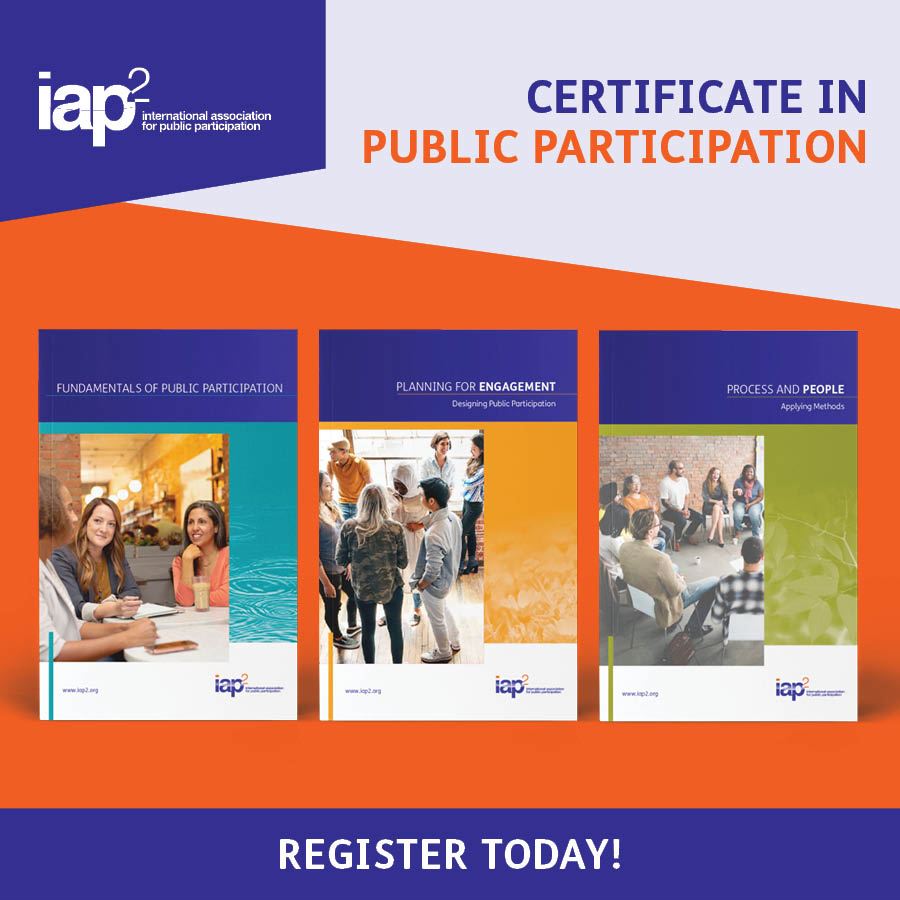As a key leader in the public participation sector IAP2 USA provides skills-based learning to people and organizations on what they need to know and do, so that they can successfully develop, deliver, and lead authentic engagement processes. IAP2 Certificate Program IAP2 USA's Certificate in Public Participation (P2) consists of 3 core courses - Fundamentals of Public Participation, Designing Public Participation, and Applying Methods. Based on IAP2's internationally recognized Global Learning Pathway, this professional development certificate program builds on the foundations of public participation training and best practices from around the globe to provide participants with over 30 hours of effective training in public participation and engagement. #1 Fundamentals of Public Participation Prerequisite for Designing Public Participation and Applying Methods The Fundamentals of Public Participation (P2) course is a prerequisite to other courses in the Global Learning Pathway that sets out the underpinning models and frameworks of engagement practice as defined by the IAP2 community. The focus of this course is on understanding and applying the practices of meaningful and effective P2 and what participants need to know to do this well. The training explores best practices, and how to design and apply this knowledge to your P2. Course objectives By the end of this course participants will be able to:
#2 Designing & Leading Public Participation Designing Public Participation (P2) is a Level 2 course that introduces practitioners to the design and plan phases of the practice framework, providing them with the opportunity to develop P2 plans. This includes scoping, community mapping, determining purpose and objectives and levels of influence, choosing appropriate methods and managing resources, while considering the needs of diverse audiences. The course is suitable for practitioners who are leading the planning and implementation of P2 processes. Course objectives:
#3 Applying Methods for Public Participation Designing Public Participation is a prerequisite for this course Applying Methods is a Level 2 course that introduces practitioners to a large number of P2 methods. This includes learning how to design specific methods, developing good question design, and having an opportunity to practice running some methods. The course is suitable for practitioners who are part of a team implementing a P2 process and are looking for the practical skills to be effective in designing and applying methods. Course objectives:
Who should attend The courses are suitable for new and emerging public participation practitioners or anyone involved in engagement projects in all levels of government, private industry, utilities, environmental agencies, community organizations, not-for-profit and education providers who would like to understand and deliver engagement in an USA context. Upon completionParticipants will receive a certificate of completion from IAP2 for each course completed. Upon completing the three core courses, participants will receive a Certificate in Public Participation. This professional development certificate program is a next step on your journey to becoming a P2 professional and separate from the IAP2 USA’s designations (CP3 & MCP3). It is important to note that participants of the Certificate in Public Participation are not certified P2 professionals. Learn more about how to become a certified P2 professional. The benefits of IAP2 USA training: 1. Practical knowledge and theory delivered in an inclusive training environment |
Do you make decisions affecting the public? Do you consult with the public as you make your decisions? Are you sometimes reluctant to include them in the conversation? IAP2’s Public Participation for Decision Makers is a three-hour session designed to show you how your decisions are so much better for consulting with the public -- the people affected by the decision. Who should take this course:
Who should not take this course:
You’ll learn:
IAP2’s Public Participation for Decision Makers helps decision makers get the best value from a public process. The session looks at the Foundations from a decision maker’s point of view and offers a perspective on how public participation can be integrated into the overall project plan. It examines the costs and benefits of public participation, discusses when and when not to involve the public in an organizational decision, and emphasizes the importance of both the decision being made and the promise to the public about their involvement in that decision process. Finally, the session provides an overview of what the decision maker should know about the public participation practitioner’s role.
|
In these challenging times of environmental, health, cultural, economic and social changes this is a course that will enhance your practice, support your clients and equip you to think about and learn how to apply behaviours that will enhance quality public participation outcomes where communities are emotional or outraged and therefore not yet at the place where they can fully participate in a public engagement process. This course will help you plan for those type of circumstances.
The use of case studies and video clips throughout the two days will demonstrate:
- Six practical strategies for managing outrage
- New behaviors that you can apply immediately
- A new way of thinking and analyzing outrage
- New ways to plan and implement public participation projects where people are outraged
Who should take the EOP2 course?
This two-day course is designed for any practitioner dealing with the tough issues facing our communities now and in the future. Anyone in communities facing complex challenges - from outreach coordinators to consultants and elected officials - would benefit by learning meaningful best practices to assess and address outrage in your P2.
This course brings together the collective knowledge and experience of outrage management as taught by Dr. Peter Sandman and public participation as practiced by IAP2. The course is highly interactive and uses a range of adult education methods including using case studies, video clips of Peter, tools and techniques used in public participation, times for personal reflection, group discussion and application of strategies. Participants receive a learning journal to record their reflections and insights and to note what is important for their work. Prior completion of Foundations in Public Participation is recommended but not required.
- No upcoming events

 We are very excited to be launching the next evolution of training that builds on our foundational best practices. Our flagship Foundations training program has been updated and now consists of three core courses. Visit our
We are very excited to be launching the next evolution of training that builds on our foundational best practices. Our flagship Foundations training program has been updated and now consists of three core courses. Visit our